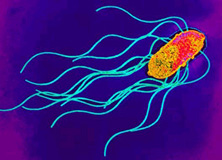Salmonella enterica NEU2011
Classification
Higher Order Taxa
Bacteria; Proteobacteria; Gammaproteobacteria; Enterobacteriales; Enterobacteriaceae; Salmonella; enterica.
Description and Significance
Salmonella is a gram-negative, rod-shaped, flagellated bacterium that is of interest due to its ability to cause infectious disease in humans and animals. Salmonella is facultative, being capable of both aerobic respiration for the production ATP as well as fermentation in the absence of oxygen. Dr. Daniel E. Salmon was the first person to identify Salmonella over 100 years ago, currently there are approximately 2,300 serotypes known. Salmonella infection is known as Salmonellosis; Salmonella enterica serovar thyphi is a subspecies of Salmonella that is responsible for typhoid fever in humans by invading the gastrointestinal tract. Much of the current understanding of cellular and molecular functions in a cell has been made possible by using Salmonella. For example, Salmonella enterica serovar Typhimurium, a subspecies of Salmonella enterica, was the first bacteria used to observe transduction by Zinder and Lederberg in 1952. Since then a vast number of discoveries have been made using Salmonella ranging from gene regulation mechanisms, to cell surface antigen interactions with immune cells.
Genome Structure
The genome of Salmonella enterica serovar Typhimurium LT2 is approximately 4,857 kilobases long and an additional 94 kilobase virulent plasmid specific to the LT2 strain. Lateral genetic transfer is common as 11% of the genes present in LT2 are missing from Salmonella enterica serovar typhi and 29% of genes are missing from Escherichia coli K12."
Cell Structure and Metabolism
Ecology
Pathology
Current Research
Cool Factor
References
Author unknown. 2006. Salmonella Questions and Answers. United States Department of Agriculture Food Safety and Inspection Service. Accessed February 19, 2011 http://www.fsis.usda.gov/factsheets/salmonella_questions_&_answers/index.asp
Todar, Kenneth PhD. 2008. Salmonella and Salmonellosis. Todar’s Online Textbook of Bacteriology. http://www.textbookofbacteriology.net/salmonella.html
Mobley, Harry LT, George L Mendz,2and Stuart L Hazell. 2001. Helicobacter pylori Physiology and Genetics. Washington, DC: ASM Press
McClelland, Michael , et al. “Complete genome sequence of Salmonella enterica serovar Typhimurium LT2”. Nature. 2001. Volume 413. P. 852-856.

